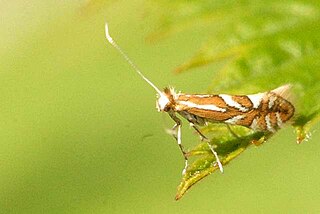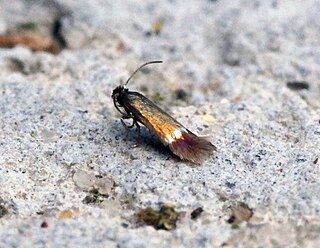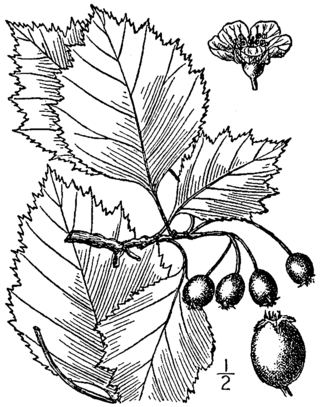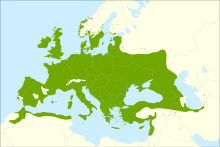
Crataegus, commonly called hawthorn, quickthorn, thornapple, May-tree, whitethorn, Mayflower or hawberry, is a genus of several hundred species of shrubs and trees in the family Rosaceae, native to temperate regions of the Northern Hemisphere in Europe, Asia, North Africa and North America. The name "hawthorn" was originally applied to the species native to northern Europe, especially the common hawthorn C. monogyna, and the unmodified name is often so used in Britain and Ireland. The name is now also applied to the entire genus and to the related Asian genus Rhaphiolepis.

Photinia is a genus of about 30 species of small trees and large shrubs, but the taxonomy has recently varied greatly, with the genera Heteromeles, Stranvaesia and Aronia sometimes included in Photinia.

Crataegus mollis, known as downy hawthorn or red hawthorn, is a species of plant that occurs in eastern North America from southeastern North Dakota east to Nova Scotia and southwest to eastern Texas. The range of this species is from southern Ontario and Michigan to eastern North Dakota and southward to Denison, Texas, and Arizona. This tree inhabits wooded bottomlands, the prairie border, and the midwest savanna understorey.

The Glastonbury thorn is a form of common hawthorn, Crataegus monogyna 'Biflora', found in and around Glastonbury, Somerset, England. Unlike ordinary hawthorn trees, it flowers twice a year, the first time in winter and the second time in spring. The trees in the Glastonbury area have been propagated by grafting since ancient times. The tree is also widely called the holy thorn, though this term strictly speaking refers to the original (legendary) tree.

Crataegus heterophylla, known as the various-leaved hawthorn, is of uncertain origin. Its original native range is not known, possibly it was the Caucasus of Western Asia. Suggestions that it originated in Southeast Europe may be based on misidentification.

Crataegus laevigata, known as the Midland hawthorn, English hawthorn, woodland hawthorn, or mayflower, is a species of hawthorn native to western and central Europe, from Great Britain and Spain east to the Czech Republic and Hungary. It is also present in North Africa. The species name is sometimes spelt C. levigata, but the original orthography is C. lævigata.

Crataegus douglasii is a North American species of hawthorn known by the common names black hawthorn and Douglas' thornapple. It is most abundant in the Pacific Northwest.
Crataegus flava, common names summer haw and yellow-fruited thorn, is a species of hawthorn native to the southeastern United States from Virginia to Florida, west to Mississippi. Due to an error by Sargent the name C. flava was, and often still is, used for a different species C. lacrimata, which belongs to a different series, the Lacrimatae series. Flavae is another group of species that were thought to be related to the misidentified C. flava, and although it is now apparent that they are not related, the name of the group remains. Because the true identity of this species has only recently been discovered, the name is rarely used correctly. Individuals with red fruit occur; these have sometimes been assigned to a separate species, Crataegus senta.
The name Crataegus oxyacantha L. has been rejected as being of uncertain application, but is sometimes still used.

Crataegus crus-galli is a species of hawthorn known by the common names cockspur hawthorn and cockspur thorn. It is native to eastern North America from Ontario to Texas to Florida, and it is widely used in horticulture. It is thought to be the parent, along with Crataegus succulenta, of the tetraploid species Crataegus persimilis.

Crataegus rhipidophylla is a species of hawthorn which occurs naturally from southern Scandinavia and the Baltic region to France, the Balkan Peninsula, Turkey, Caucasia, and Ukraine. It is poorly known as a landscape and garden plant, but seems to have potential for those uses.

Crataegus × media, is a hybrid between two species in the genus Crataegus (Hawthorn), C. monogyna and C. laevigata, both in series Crataegus. Under the rules of botanical nomenclature the name C. × media covers all intermediate forms between the two parent species, including backcrosses.

Crataegus mexicana is a species of hawthorn known by the common names tejocote, manzanita, tejocotera and Mexican hawthorn. It is native to the mountains of Mexico and parts of Guatemala, and has been introduced in the Andes. The fruit of this species is one of the most useful among hawthorns.
Crataegus × macrocarpa, is a hybrid between two species of Crataegus (hawthorn), C. laevigata and C. rhipidophylla, both in series Crataegus. A chemotaxonomic investigation comparing flavonoid patterns in C. × macrocarpa and its putative parent species corroborated their supposed relationship. It is sometimes confused with C. × media, the hybrid between C. monogyna and C. laevigata.

Phyllonorycter oxyacanthae is a moth of the family Gracillariidae found in all of Europe except the Balkan Peninsula. It was described by the German-born Swiss entomologist, Heinrich Frey in 1856. The larvae are known as leaf miners, living inside the leaves of their food plants.
Stigmella oxyacanthella is a moth of the family Nepticulidae, found in Europe and North America. The larvae are leaf miners feeding inside the leaves of trees and shrubs, such as hawthorn, apple and pear.

Stigmella hybnerella also known as the greenish thorn pigmy is a moth of the family Nepticulidae. It is found in all of Europe, in North Africa, the Near East, and the eastern part of the Palearctic realm. The larvae mine the leaves of trees and shrubs such as hawthorns and rowans.

Stigmella crataegella is a moth of the family Nepticulidae found in Europe. It was described by the Austrian entomologist Josef Wilhelm Klimesch in 1936. The larvae mine the leaves of hawthorns.

Crataegus brainerdii is a species of flowering plant in the rose family known by the common name Brainerd's hawthorn. It is named for Ezra Brainerd (1844–1924), a renowned botanist and former president of Middlebury College, in Vermont.

Crataegus persimilis is a species of hawthorn, known by the common names plumleaf hawthorn and broad-leaved cockspur thorn, native to southern Ontario, Canada, and the US states of New York, Pennsylvania, Ohio, Kentucky, West Virginia, and Virginia. It is widely cultivated, particularly in Europe, as an ornamental. Its sporadic distribution in its natural range and certain of its morphological characters leads authorities to consider it a probable naturally occurring hybrid, with its most likely parents being Crataegus succulenta and Crataegus crus-galli. It is a tetraploid. Some populations may be self-perpetuating. Its 'Prunifolia' cultivar has gained the Royal Horticultural Society's Award of Garden Merit, and is considered one of its top 5 trees for smaller gardens.






























